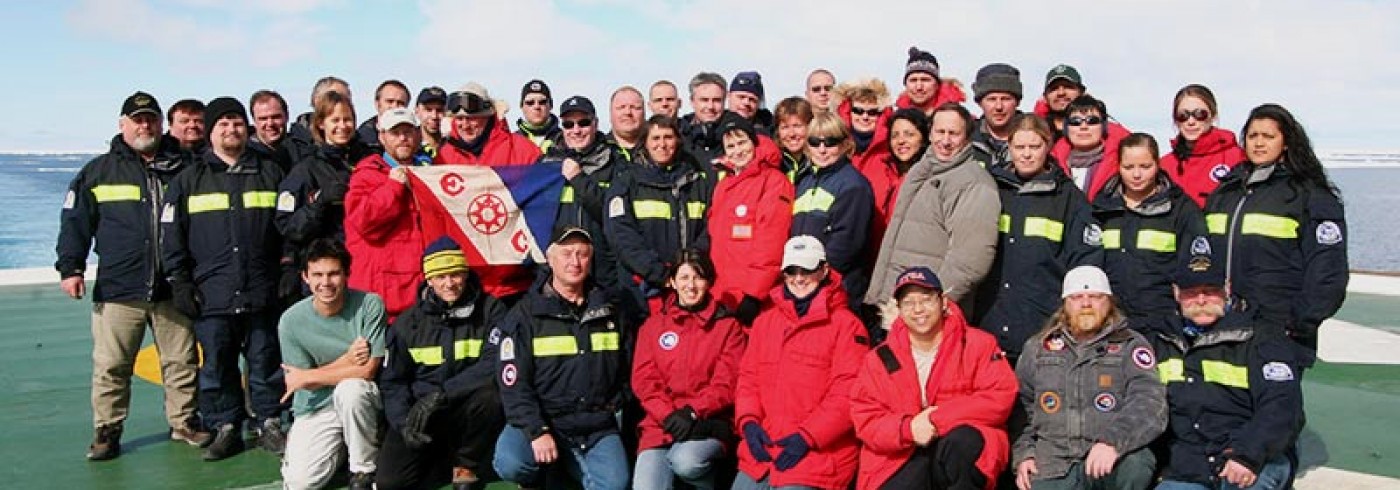Though the Oden’s primary mission was to establish the re-supply channel into McMurdo Station in late December 2006 and early January 2007, the ship’s transit from Punta Arenas, Chile to McMurdo Sound provided a platform of opportunity for scientists from Sweden, the United States, and Chile to conduct limited, collaborative ship-based research through the Amundsen, Bellingshausen, and Ross seas. The science programme consisted of nine research projects involving 17 scientists and technicians including 3 from Sweden (2 on-board), 12 from the United States (8 on-board), and 2 from Chile.
Education and outreach
An extensive education and outreach program was also developed and executed during the expedition’s transit. It included five educators (Ingela Hagström from Uddevalla gymnasieskola in Sweden, Ute Kaden from Homer High School in the U.S., Valentine Kass and Allan Miller from the U.S. National Science Foundation, and Sandra Williams Pinto from the University of Concepción in Chile) who collaborated with each other on the various national activities, and one science journalist (Daniel Grossman from the United States). Nine satellite-linked telephone calls and teleconferences were made to the U.S. and to Sweden during the transit. Two were PolarTREC tele-conferences with schools in the U.S., three were direct calls to U.S. schools which engaged a total of 19 schools throughout continental U.S. and Alaska, three were direct calls to Swedish schools and one was a direct call to a Chilean school. The science journalist was interviewed during a satellite phone call by an Australian public radio science show on 22 December and by a radio station in the United States when the Oden arrived at McMurdo Station.
A reception for the crew, scientists, educators and local media was hosted by the Antarctic Institute of Chile (INACh) on 10 December in anticipation of the Oden’s departure and inauguration of the 2007–2009 International Polar Year (IPY). A number of newspaper stories subsequently appeared in the Chilean press and press releases were issued by the Chilean, Swedish, and U.S. national science programs.
The route to McMurdo
The Oden departed Punta Arenas, Chile, on 12 December 2006, passed Cape Horn on 14 December then crossed the Antarctic Circle on early afternoon of 18 December, followed by a festive crossing ceremony. The Oden’s course continued well offshore and outside of the pack ice from 18 through early on 20 December owing to continued good weather and the need to make good speed for a timely arrival at the ice edge near Ross Island. A small ice field was encountered on 20 December and traversed within several hours. Waters remained clear of pack ice, though large tabular icebergs were common, until around just after midnight on 22 December when the eastern margin of the main ice field of the Ross Sea and western Amundsen Sea was reached. Large tabular bergs remained common until around 1300 hrs on 23 December when multi-year pack ice began to dominate and icebergs became rare. The pack ice increased through 23 December and was extensive, mostly first year ice with patches of second and multi-year ice scattered, until the Oden cleared the ice field into the Ross Polynya late on 26 December. Several Christmas celebrations were held on board between 23 and 25 December.
The Oden arrived at the fast ice edge just north of Cape Royds, Ross Island, around 1430 hrs on 27 December and immediately began cutting the ship channel into McMurdo Station until stopping just west of Cape Evans and north of the Delbridge Islands at 1700 hrs to receive a briefing delegation from McMurdo Station. The ship then turned north, cut another swath to the ice edge and then returned south to cut a third swath arriving back just off Cape Evans by 0600 hrs on 28 December. All scientists and educators were transported by helicopter from the Oden to McMurdo station between 0830 hrs and 1100 hrs on 28 December, then departed McMurdo on a C-17 jet flight to Christchurch, New Zealand at ca 1430 hrs, arriving at Christchurch at ca 2200 hrs.
Principal investigators
Agneta Fransson and Melissa Chierici
University of Gothenburg

